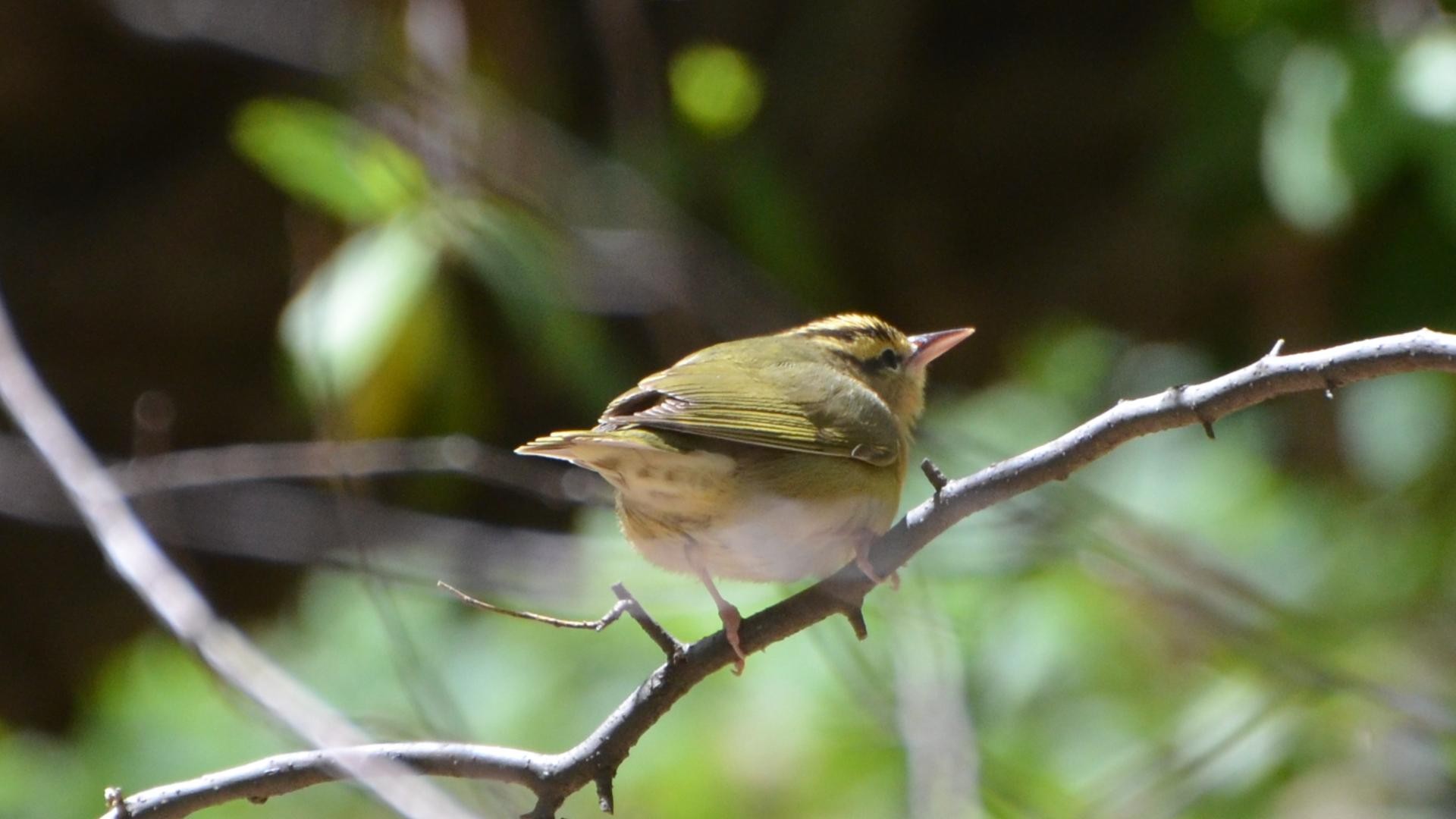Worm-eating Warbler
A species of Worm-eating Warblers Scientific name : Helmitheros vermivorum Genus : Worm-eating Warblers
Worm-eating Warbler, A species of Worm-eating Warblers
Botanical name: Helmitheros vermivorum
Genus: Worm-eating Warblers
Content
Description People often ask General Info
 Photo By Andy Reago & Chrissy McClarren , used under CC-BY-2.0 /Cropped and compressed from original
Photo By Andy Reago & Chrissy McClarren , used under CC-BY-2.0 /Cropped and compressed from original Description
The worm-eating warbler is a small New World warbler. Measurements: Length: 4.4-5.2 in (11.2-13.1 cm) Weight: 0.4-0.5 oz (12-14 g) Wingspan: 7.9-8.7 in (20-22 cm) It is relatively plain with olive-brown upperparts and light-coloured underparts, but has black and light brown stripes on its head. It has a slim pointed bill and pink legs. In immature birds, the head stripes are brownish. The male's song is a short high-pitched trill. This bird's call is a chip or tseet. Worm-eating warblers are sexually monomorphic. Males and females can only reliably be sexed during the breeding season by the presence of a brood patch in females or a cloacal protuberance in males. These birds are also difficult to age. Hatch year/second year birds have rusty tips on tertials that wear off by March of the following year. Juveniles can be distinguished by duskier head markings, and cinnamon wingbars. 
Size
13 cm (5.25 in)
Colors
Brown
Black
Green
Bronze
Life Expectancy
7 years
Nest Placement
Ground
Clutch Size
4 - 6 eggs
Incubation Period
1 brood
Number of Broods
11 - 17 days
Nestling Period
9 - 11 days
Feeding Habits
Worm-eating Warbler primarily consumes caterpillars, grubs, and other invertebrates such as slugs, spiders, and various insect larvae. These are obtained by gleaning from vegetation and leaf litter within forest interiors up to about 18 feet high, as well as dead leaves and vine tangles in tropical winter habitats. Unique to worm-eating Warbler is gap feeding, where food is captured by probing into crevices and expanding the bill to extract prey. Diet varies with habitat; they rarely feed on earthworms as their name might suggest.
Habitat
Worm-eating Warbler prefer mature deciduous and mixed hardwood forests with shrubby understory, mainly on hilly or sloped landscapes. Their adaptable nature allows for varying altitudes and climates, inhabiting beech-maple, oak-hickory, and rhododendron areas. Coastal and interior populations differ slightly in habitat preference, but intact, large forests are essential for breeding. They also adapt to scrub and moist forests in southern regions during migration and winter.
Nest Behavior
Worm-eating Warbler exhibits distinct nesting habits with the female selecting the site and constructing the nest. Nest-building, egg-laying patterns, and parental responsibilities are synchronized with seasonal cues, ensuring optimal conditions for brood rearing.
Nest Characteristics
Worm-eating Warbler's nest is typically a ground-level structure located on sloping terrain, commonly at the base of shrubs or saplings, near water. It consists of a cup-shaped construction made with skeletonized leaves, lined with moss, hair, fine grasses, and pine needles, measuring approximately 8 cm in diameter.
Dite type
Insectivorous
People often ask
General Info
Feeding Habits
Bird food type
Bird Feeder Type

Platform
Behavior
Worm-eating Warbler exhibit monogamous tendencies, with occasional instances of bigamy. Their elusive nature has left their courtship rituals undescribed, while their territorial displays involve a distinct 'bow' and 'gape'. Conflict may result in a 'freeze', showcasing their head pattern and bill. They establish roughly 4.3-acre territories swiftly in spring, aggressively defending against conspecifics and even larger passerines. Both sexes engage in rearing the young, with males ceasing territorial aggression post-fledging. In winter, worm-eating Warbler maintain territories but will integrate into transient mixed-species foraging groups.
Distribution Area
These birds breed in the Eastern United States. Their selected habitats vary significantly between populations. In much of their range, worm-eating warblers are associated with mature hardwood forests on steep slopes. However, recent attention has been focused on coastal breeding populations, as little is known about their ecology or status. Historically, coastal populations would select for pocosin ecosystems. More recently, however, these populations have shifted to frequent use of pine plantations. Current use of pine plantations has resulted in densities higher than in areas previously thought to be their natural habitat. This shift in habitat selection likely demonstrates that worm-eating warblers are more closely associated with shrub structure than stand age or size. If this is the case, the landscape changes that occurred on the Atlantic coastal plain may have had less of an impact on these birds than previously described. Maintaining this species habitat may require managing for dense shrubby midstory and understory. Due to their reliance on shrub structure for foraging, and ground nesting behavior, frequent fires have a negative impact on this species. Other management strategies that reduce the shrub mid-story, increase herbaceous growth, and decrease canopy cover are likely to have a similar effect. More information is needed about their breeding habits in coastal regions as these forests are likely to represent different conditions from their inland counterparts. Fat deposits play a key role in allowing for long distance migration in most passerines. Stopover habitat, or areas that allow birds to replenish their fat stores, are also critical. In winter, these birds migrate to southern Mexico, the Greater Antilles, and Central America particularly along the Caribbean Slope where they occupy both scrub and moist forests. Worm-eating warblers have disappeared from some parts of their range due to habitat loss but their ability to use both scrub and moist forest ecosystems may be beneficial to the long term conservation of this species. 
Species Status
Not globally threatened.

 Photo By Andy Reago & Chrissy McClarren , used under CC-BY-2.0 /Cropped and compressed from original
Photo By Andy Reago & Chrissy McClarren , used under CC-BY-2.0 /Cropped and compressed from original Scientific Classification
Phylum
Chordates Class
Birds Order
Perching birds Family
New world warblers Genus
Worm-eating Warblers Species
Worm-eating Warbler